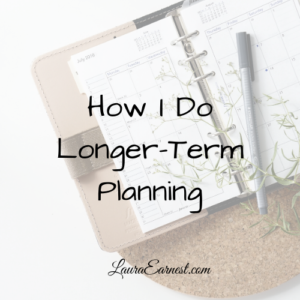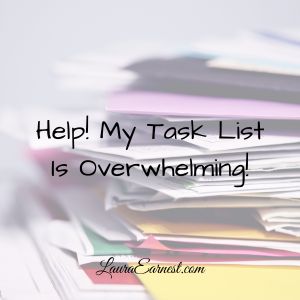Daily and weekly planning will get you through the day-to-day without having tasks pile up for a massive weekend task-fest. But isn’t there more to life than just the day-to-day?
For a long time I existed on daily and weekly planning only. Partially it was because I was just so busy juggling all of my commitments (work, child, house, spouse and volunteer) that I didn’t have room for anything more. I would plow through my days, insanely productive, falling into bed at night exhausted. But there was never anything more. The novel I wanted to write remained a remote dream, and my craft closet morphed into a craft room with supplies for unstarted projects.
Partially it was because I was completely flummoxed by the thought of thinking of a 5- or 10-year plan. I couldn’t even see the end of the week for the enormous pile of tasks. How could I plan for anything more?
Why I Hate Year-Long Planning
Even bringing it down to a year was almost impossible. Sure, I found some help actually creating the plan. But once the plan was created, it sat as a nice pile of undone tasks because I had other things to do. After all, I had plenty of time, right? It was only the (first, second, third) quarter, and I still had lots of time to get things done before the end of the year.
I hope you’re laughing, because I certainly am.
I never got to those tasks because I was afflicted with grasshopper syndrome. I always thought I had enough time, and never actually got to the work, until it was too late.
I also fell victim to the thought that year-long plans needed to follow the calendar year. And my last quarter was always overfull with holiday activities. As a musician, December is my busiest month, and November is packed with rehearsals. Throw in National Novel Writing Month and the fourth quarter is gone.
So I started to hate year-long planning.
Why I Started Quarterly Planning
It was around this time that I read The 12 Week Year*. What a concept! To condense 12 months into 12 weeks. Sure, I had to scale the projects back, but 12 weeks is much less prone to the grasshopper syndrome.
I even developed my own plan on how to do this. I took what I liked out of the 12 Week Year, discarded the parts that seemed pointless, and added in what I had learned from Covey, Allen and Forster.
This planning workbook, along with an spreadsheet version that is even quicker, is available for purchase. Scroll to the bottom of the post for the link.
Why I Moved To Monthly Planning
With my enforced stay at home due to COVID19, I have shrunk this a bit further. Since I don’t know what life will look like in a month, much less a quarter, I am now doing monthly planning. Things are just too uncertain at the moment to be able to count on time allocation or resources.
For instance, one of the projects that was on my previous 12 weeks was to learn a piece for my daughter’s senior recital. Right as the stay-at-home order was given my flute had a key malfunction that rendered it unplayable (and I don’t have the tools to fix it). With the stay-at-home, I can’t get it fixed. Further, school was cancelled for the rest of the year, and if and when my daughter was going to do the recital was up in the air.
I simply had to narrow the focus from 12 to 4 weeks, quarter down to month.
I use the same planning workbooks/spreadsheet as for the 12 weeks, but I just fill out the first four weeks.
My Monthly Plan Method
The trick to doing any extended planning is to know on which projects you are going to focus. So at the start of my planning phase I pull up a spreadsheet where I have listed all my projects.
Next I weight them by percentage complete, hours to complete, resources on hand, ROI, impact and irritation factor. (Yes, I’m a numbers geek. But it works).
Then I sort by the resulting number. The result is I have a list of projects that are weighted according to my factors.
From there I know what the 3-4 projects are that I will be concentrating on in the next month. If I think that the project is going to take more than I can give it in the month, I break it down into something I can get done during that time. And then split it into actions by week.
This gives me a list of actionable steps that I can work into my weekly plan, and from there, into my daily tasks.
Conclusion
One can survive doing only weekly and daily planning. But to really make progress on bigger projects, you need to do a bit bigger planning. Because of the grasshopper factor, it is better to plan in smaller increments based on situation and capacity.







